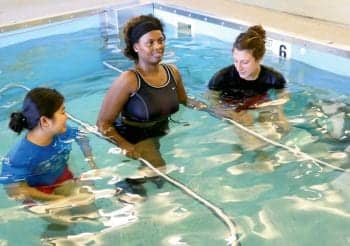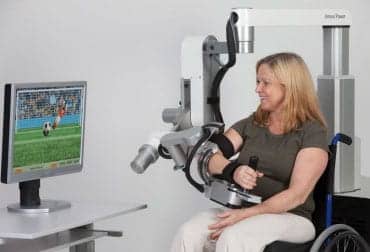PHOTO CAPTION: A participant wearing a pair of prism goggles used in prism adaptation therapy. (photo courtesy of Kessler Foundation)
Seeking ways to improve outcomes of stroke rehabilitation, researchers from Kessler Foundation explored available evidence for the neural mechanisms of prism adaptation therapy, an intervention with efficacy for the treatment of spatial neglect.
They analyzed published fMRI studies conducted in healthy individuals and stroke survivors with spatial neglect. Their article was published open access in Brain Sciences.
The authors are Olga Boukrina, PhD, and Peii Chen, PhD, of Kessler Foundation. The authors have academic appointments at Rutgers New Jersey Medical School.
Spatial neglect, a neuropsychological syndrome affecting 30% of stroke survivors, is characterized by disordered processing of spatial information and diminished control of attention. Prism adaptation treatment using prism goggles has been shown to improve symptoms of spatial neglect, which poses safety risks and hinders progress in rehabilitation.
Outcome studies are mixed, however, and the determinants of short- and long-term benefits are unclear.
“Approximately 25 percent of individuals with spatial neglect poststroke fail to benefit from prism adaptation treatment. Investigating the neural mechanisms that underly the responses to prism adaptation may provide the direction needed to increase the clinical efficacy of this treatment.”
— Olga Boukrina, senior research scientist in the Center for Stroke Rehabilitation Research at Kessler Foundation
The team conducted a scoping review and meta-analysis of 15 published papers on prism adaptation and fMRI.
“We found that healthy adults and stroke survivors with spatial neglect rely on different neural mechanisms during prism adaptation.”
— Peii Chen, senior research scientist in the Center for Stroke Rehabilitation Research
After a single session of prism adaptation, healthy adults increased cerebellar-parietal activation, while individuals with spatial neglect after right brain stroke exhibited activity in different circuits, including a cluster in the intact left hemisphere.
“These findings are consistent with a shift in spatial processing to the left hemisphere in spatial neglect caused by right hemisphere stroke,” Boukrina adds. “More research is needed to clarify how lesion location and load on the circuits influence the response to prism adaptation treatment that involves a course of multiple sessions over weeks. Findings will help us identify patients most likely to benefit from prism adaptation treatment and find ways to maximize the benefits for stroke survivors with spatial neglect.”
[Source(s): Kessler Foundation, EurekAlert]





